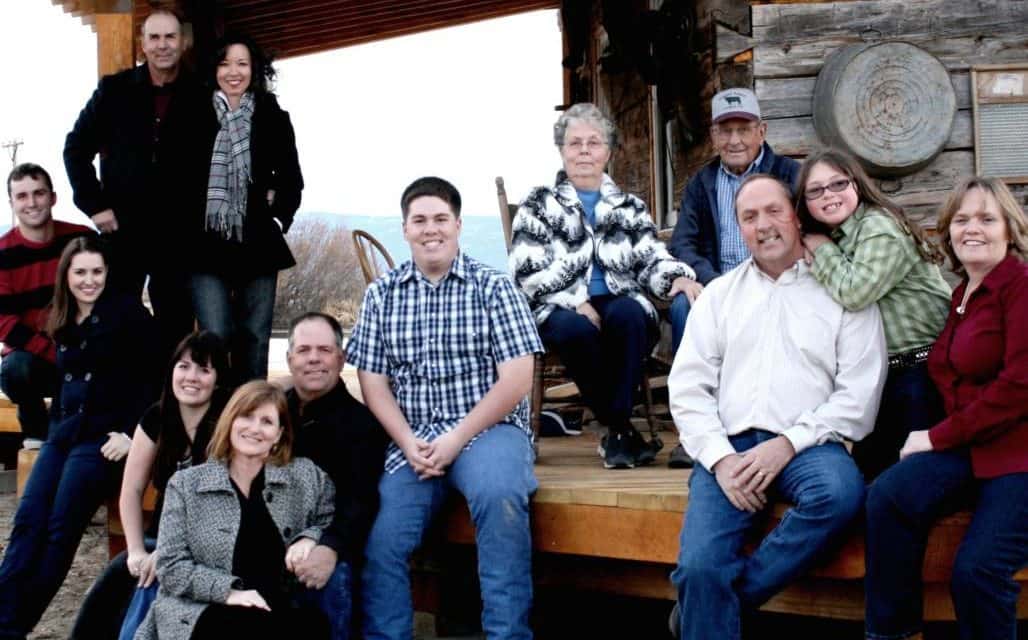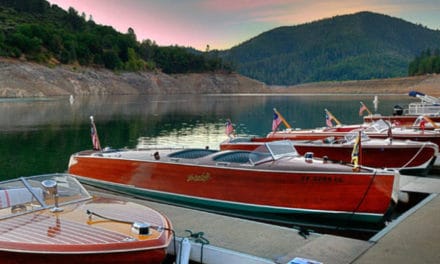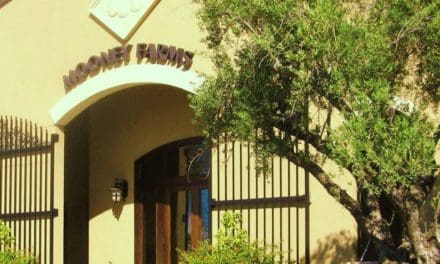Roberti Ranch:
A Time Honored Partnership with the Land
By Debra Hasbrouck
Living in the mountains can be an extraordinary experience—spectacular beauty is a daily standard, often accented with breathtaking seasonal changes. Although the volatile weather may be exciting, it can create challenges for the residents of these majestic environments.
In the time that Sierra Valley was my home, I developed a deep sense of respect and admiration for the farmers and ranchers who live and work in the big, mountain valley. The level expanse sits at just under five-thousand feet elevation and the surrounding mountains seem to create a chilly, micro-climate. It’s not uncommon for winter temperatures to dip well below zero or for a hard frost to hit in June.
For almost a century, the Roberti family has honored a commitment to the Sierra Valley land that they call home. According to Rick Roberti, his grandparents, Alfred and Josephine Roberti, started in 1922 with a small dairy on the property northwest of the existing main ranch. The couple had two children, Elia and Elmer, who grew up helping their parents on the family dairy and attended a one-room school three miles away.
Alfred and Josephine, along with their son, Elmer, began a transition to beef cattle in 1952 when they purchased 30 registered Angus cows. Today, Roberti Ranch has about 400 commercial mother cows. Approximately 200 of those calve in the spring and stay in Sierra Valley year-round. The rest of the cows calve in the fall and spend winter down in the foothills. The drought has forced the family to sell about 100 cow-calf pairs due to a shortage of feed.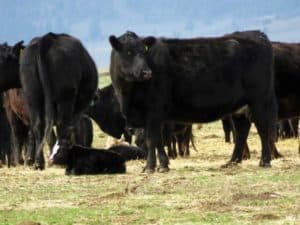
For eighty-seven years, Elmer Roberti lived and worked on the ranch—a lifetime filled with family devotion and hard work tending the land. Elmer left an extraordinary legacy when he passed away in October of 2012. His wife, Helen, is still an integral part of the ranch and can be found throughout the week, cooking and serving lunch at her big dining table.
The ranch has remained a family operation, with Elmer and Helen’s three sons—Jim, Rick and Dave—living and working on the home place. All members of the family are involved in some way.
Rick and his son, Weston, take care of the cattle and produce livestock hay on dryland (non-irrigated) pasture. Rick’s wife, Carolyn, developed a ranch calendar that she uses to help coordinate ranch schedules. She keeps everyone informed about daily plans, which is vital for a family business. Rick and Carolyn’s daughter, Katie, will graduate from Cal Poly in June with a degree in Agricultural Communication.
Jim and Dave work with Jim’s son, Ben and son-in-law, Jay Gant, on alfalfa production and harvest. Their alfalfa crop yields about six to seven thousand tons per year. Jim’s daughter, Jenny Gant, also helps to cut hay in the busy summer months.
The business end of things is handled by Dave and his wife, Jane. They also manage hay sales. Their daughter, Kristin, raises dairy goats and has a market steer for 4-H.
Over the years, the family-run ranch has grown to its current size of nearly 6,000 acres. They grow sprinkler-irrigated plus dryland alfalfa on about 2,000 acres and native pasture makes up most of the remainder.
There are also wetland areas on the property that they continue to enhance and preserve. “A love of the land has always existed and through the decades we find better ways to be in harmony with the environment,” Rick said.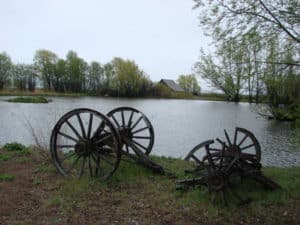
With the help of the County Extension Service and the National Resource Conservation District, the Roberti family has improved existing ponds and created new wetlands. “Construction is also underway for a seventeen acre wildlife habitat,” Rick said. “It will include ten acres of open water with nesting islands and coves where ducks can raise their hatch safely throughout the summer.”
On a rainy, spring day I was able to participate in a ranch tour that Rick and Carolyn hosted for the Plumas Audubon Society. It was the perfect opportunity to see direct results of the family’s hard work and planning.
We took off in the Roberti’s re-purposed transit bus, with Weston at the wheel and his cousin, Jenny, co-piloting from a seat behind him. Her son, Emmett, was spending some time back at the main ranch with his great-grandmother, Helen.
Our first stop was at a distant barn where a few geese nested on hay bales. Rick called our attention to a pair of owlish eyes peering out from a wooden box up in the rafters. He explained that a man from Washington State installed the box and collects the owl pellets (regurgitated wads that contain parts of bone and hair from their prey) for schools to use during classroom dissections.
After driving past green fields inhabited with curious cows, we came to a shallow lake, heavily populated with multiple varieties of waterfowl and shorebirds. According to comments from Audubon members, the three-foot depth of its water is perfect for migrating birds.
“The lake is much bigger than last year,” Rick explained. “But the water table is still down and we need more to recover from the drought.” While the birders surveyed the lake with binoculars, they kept mentioning the term “peeps.” I soon learned that “peeps” are small, unidentified shorebirds.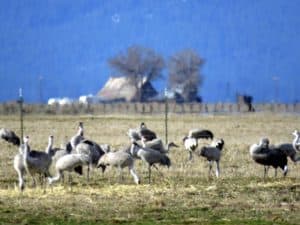
It didn’t take long for the Audubon members to identify all of the species present. I was amazed at their vast knowledge of birds, especially when it came to the subtle differences of each type. The sharp eyes of the birders also spotted a bald eagle on the opposite shore.
Rick and Carolyn explained that they have always had an interest in birds and recently became members of the Plumas Audubon Society. This is the second year they hosted a tour for the group. “I now take a camera with me when Rick and I check cows,” Carolyn said while showing us a fascinating video she had taken of dancing Sandhill Cranes.
As we bumped down another dirt road, Rick pointed out the differences in grazed and un-grazed areas. “The land responds well to grazing and the birds seem to like feeding where the cows have been,” he said. “The fenced-off areas are great for nesting.”
Our next stop was beside a beautiful irrigation pond with willows planted along its banks. The area was like a popular avian resort, with birds bobbing in the water and circling overhead. A nesting goose occupied a man-made island in the center of the pond.
Next to the shore stood a beautiful, old cabin with a covered porch and a wooden dock. As we explored the structure, Rick told us that it was estimated to be of the same era as the Beckwourth Cabin (circa 1852 according to the Eastern Plumas Chamber of Commerce). Along with members of their church, they had moved it, piece by piece from a nearby field and rebuilt it with a new roof. It now serves as a place for family gatherings and a “prayer cabin” for their church.
We finished our tour by visiting an area where burrowing owls had recently been seen. Using a scope, one birder spotted a burrowing owl on a distant fencepost and offered everyone a look. As we turned back toward the main ranch, three pronghorn antelope grazed nearby, giving us a memorable farewell.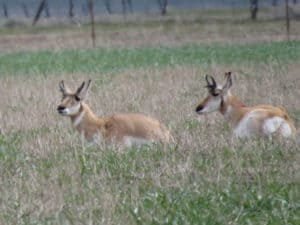
The Roberti Ranch is a wonderful example of how agricultural families are working hard to produce food, while preserving the precious land that is entrusted to them. Farmers and ranchers everywhere embrace a way of life that shares a special partnership with nature. It’s an ancient dance that moves with the rhythm of the earth and is guided by the tempo of the seasons.
For more information, they have an excellent website at www.robertiranch.com. Roberti Ranch sells alfalfa and some grain hay. Their email address is robertiranch@gmail.com
According to David Arsenault, executive director of the Plumas Audubon Society, fifty species of birds were identified that day. Their website is www.plumasaudubon.org.

